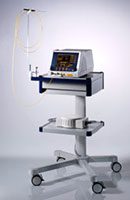Contact Us Today
For all enquiries you can email us at info@hunterveinclinic.com.au or call
ph: 4933 0431
Endovenous Laser Treatment (ELT)
Endovenous Laser Treatment of varicose veins is a relatively recent technique which has rapidly gained popularity amongst phlebologists, surgeons and their patients.
It represents a breakthrough in the modern management of varicose veins. It provides a less invasive method of treatment when compared to traditional surgical techniques such as “ligation and stripping”. The procedure involves closure of large varicose veins from the inside using heat generated by laser energy. ELT has been used in the U.S.A. since the late 1990s and in Australia since the early 2000s. ELT is used to treat large varicose veins such as the great or small saphenous veins. After laser treatment the remaining varicose and superficial veins may be removed by ultrasound guided sclerotherapy (UGS) or phlebectomy.
The Hunter Vein Clinic uses a 1470nm (wavelength) laser system manufactured by Biolitec.

The treatment is usually performed in the office under local anaesthetic and involves ultrasound guidance to access the vein, accurately position the laser fibre and monitor treatment. Branch varicosities are usually treated by ultrasound guided sclerotherapy (UGS) 1-2 weeks after laser treatment.
The Procedure
You will be asked to arrive 1 hour prior to the procedure. The sonographer will perform a brief ultrasound scan to mark the position of the vein prior to treatment and apply an anaesthetic cream (Emla) along the course of the vein. An injection of heparin (Clexane) may given prior to the procedure to reduce the risk of thrombosis.
The procedure is performed with you lying on an examination couch. Your leg will be covered with sterile drapes. Using ultrasound, the precise location of the vein is determined and a puncture is made using an introducer needle through an anaesthetized site. This is usually on the inside of the thigh or knee for the great saphenous vein (GSV) or posterior calf for the small saphenous vein (SSV). Via the introducer needle, a guidewire is advanced along the vein and a small catheter is fed over the wire and accurately positioned using ultasound guidance. Local anaesthetic is infiltrated around the vein at several levels using a fine needle. The laser fibre is then positioned and energy is delivered as the fibre is slowly withdrawn, thus “heat sealing” the vein. Minimal discomfort is experienced during the procedure due to the action of the local anaesthetic.
Although treatment with ELT will often reduce the size of varicose branches in the thigh and calf it is usually necessary to treat any residual veins with sclerotherapy or phlebectomy. This is usually performed 1 – 2 weeks later.
Aftercare
A Class II compression stocking will be applied following ELT. This is necessary to maintain pressure on the treated vein and prevent any refilling of blood. It is usually worn for 4 – 7 days continually and a further 7 – 10 days during the day. You will be required to walk for 20 minutes immediately following ELT and for at least 30 minutes daily.
It is strongly recommended that someone drive you home if possible, although not required by law as no sedation is used during the procedure.
Avoid vigorous exercise or strenuous activities for the first 2 – 4 weeks. Most occupations may be resumed the next day, although in heavy manual occupations 7 – 14 days off is recommended.
Mild to moderate pain is usually experienced during the first few days after treatment however pain and discomfort (particularly a “pulling” sensation) tends to intensify 7 – 10 days post treatment and may persist, although to a diminished degree, for up to 2 – 3 weeks. This is normal and simple analgesia such as paracetamol or Ibobrufen (e.g. Nurofen) is recommended.
Bruising down the length of the treated vein is common due to blood escaping through the walls of the veins at the time of treatment. Bruising may become evident over a number of days.
Discolouration along the course of the treated vein is common and is due to inflammation of the vein and pigmentation from the escaped blood.
Tender lumps may occur due to inflammation and trapped blood within the treated vein. This may be removed through a small needle puncture.
Possible Complications and Adverse Effects of ELT
Deep Venous Thrombosis
Very rarely a clot may form or extend from the site of treatment into the deep veins. This is extremely rare but potentially serious as a piece of clot may break off and travel to the lungs (pulmonary embolus) or brain (stroke). The protocol of walking daily and wearing the compression stocking is very important to minimize the possibility of this complication. Signs and symptoms of thrombosis include excessive swelling and pain in the leg, and shortness of breath or chest pain may indicate a pulmonary embolus. DVT requires urgent medical treatment with blood thinning injections or hospital admission in more severe cases. Please advise Dr. Hunter if you have any past or family history of thrombosis, or if you are on hormone treatment such as the oral contraceptive pill or hormone replacement therapy. It is not advisable to have surgery performed for 6 weeks before or after ELT or to schedule a long distance trip such as plane travel.
Superficial Thrombophlebitis
The treated vein may feel tender and lumpy along its course and this reflects the underlying inflammation which is part of the treatment and healing process. Occasionally the vein will become more inflamed as manifest by heat, redness, pain and swelling along its course or in discreet lumps. If this occurs it is advisable to continue wearing the compression stocking, take anti-inflammatory medications such as Naprosyn or Nurofen (if tolerated) and walk regularly. Rarely, antibiotics may be prescribed if the area is particularly inflamed although infection is seldom present. Please notify Dr. Hunter if you are worried about this problem.
Infection
Infection following endovenous laser treatment is extremely rare. A superficial infection may occur at the needle puncture site and the signs and symptoms include heat, redness, pain and localised swelling. Very rarely a more serious infection may occur such as cellulitis, abcess formation or septicaemia. More serious symptoms suggesting infection include fever, flu-like symptoms as well as localised redness and swelling. Patients with joint replacements or artificial heart valves may need antibiotic prophylaxis prior to ELT. This must be discussed with Dr Hunter at your initial consultation.
Pigmentation of the Skin
This may occur along the course of the treated vein and is caused by deposition of iron pigment under the skin surface. Most cases fade over 3 – 6 months but may persist for over 12 months in a minority of patients.
Nerve Damage
The heat generated by laser energy can occasionally cause damage to adjacent nerves or other tissues. This may cause numbness which is usually mild and resolves over weeks to months. Very rarely more severe damage to a nerve may occur leading to permanent numbness or weakness. This complication has not been experienced at our clinic, where great care is taken to infiltrate adequate local anaesthetic mixed with saline to protect surrounding tissue.
Skin Burns
Heat generated by the laser may cause a skin burn, but as described above, meticulous care is taken to inject adequate local anaesthetic and saline around the vein to protect adjacent tissues.
Laser Safety
Hunter Vein Clinic practises recommended safety procedures and protocols when performing laser treatment, including protective safety glasses. Please discuss this aspect with Dr. Hunter if further information is required.
Failure of Treatment
This is rare following ELT but a vein may remain patent (open) in less than 1% of cases. In 5 – 10% of cases the vein may not completely close off and may open up again over months to years. The medical term for this is recanalisation.
Follow-up
It is usual to perform ultrasound scanning 1 – 2 weeks after ELT to ensure the vein has closed and exclude deep venous thrombosis. Follow up treatment of the varicose branches by UGS is often performed at this time. A follow up ultrasound scan is performed 12 months after ELT as part of the treatment plan. Dr. Hunter places great importance in the follow up of her results. A follow-up regime may be recommended on an individual basis, depending on the severity of venous disease.
Recurrence of veins following ELT
Treated correctly the veins should not reopen following ELT however a low rate of recanalisation (<5%) has been reported. New varicose veins may occur over time as the underlying tendency to form varicose veins cannot be changed. These recurrent veins can also be successfully treated. It is important to remember that ELT ablates the major trunk of the vein, and that further treatment is usually required for the varicose branches, usually at a subsequent session 1 – 2 weeks later.

